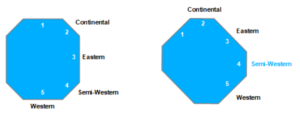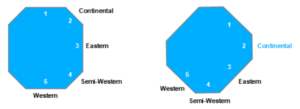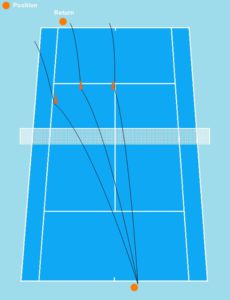Learn return
In 5 steps to the perfect tennis return as a beginner
In 5 steps to the perfect tennis return as a beginner
The return is the first shot after an opponent’s serve and therefore occurs in almost every rally – except when a double fault or ace is hit. Therefore, it is important to practice the return again and again, because the return is crucial for how you start the rally.
There are two basic return variations: In the first variant, you take the tempo of the opponent’s serve as far as possible and return the ball aggressively. In the second variant, you stand a little further back and play the ball defensively back into the court to get into the rally.
In the following, we explain to tennis beginners the 5 steps to the perfect tennis return: from the return grip, the right starting position, the appropriate movement and possible tactics to return tips.
1. Tennis grip for return
Since the serve can be played on either the forehand or backhand side, it is important to have the correct initial grip position while waiting for the return.
We set up for an aggressive return, i.e. we want to return with the forehand or backhand with topspin:
a) Tennis beginner with two-handed backhand.
Your strong hand, as with the forehand, again attacks as far down the handle as possible. With the two-handed backhand, you also take your weaker hand – the left hand if you are right-handed. Both hands are close together and touching to give the backhand even more stability.
With your strong hand you use the so-called Semi-Western grip, where the tennis racket is slightly bent forward in the lateral position at the top.

Your weaker hand, on the other hand, is in the backhand grip, since you do not need it for the classic one-handed forehand stroke. You can derive the correct grip position by imagining you are playing a two-handed backhand. For this you would go into the backhand grip, the so-called Continental grip, with the strong hand and place the weaker hand tightly on top. The club is slightly bent forward in the lateral position at the top.

In this starting grip position: strong hand in forehand grip and weak hand in backhand grip you are ideally prepared.
For a forehand stroke you simply take the weak hand off the tennis racket and you can return with forehand topspin.
For a backhand stroke you simply turn the strong hand from forehand to backhand grip and you can return with backhand topspin.
b) Tennis beginners with one-handed backhand
With the strong hand, the starting grip is exactly the same as with the two-handed backhand for a topspin return: in the so-called Semi-Western grip.
The weak hand, on the other hand, holds the racket comfortably. If the serve is played on the backhand, the weak hand grips the tennis racket and the strong hand turns from the Semi-Western grip to the Continental grip, the backhand topspin grip.
In this starting grip position: strong hand in forehand grip and weak hand in comfortable grip on the handle of the tennis racket you are ideally prepared.
For a forehand stroke you just take the weak hand off the tennis racket and you can return with forehand topspin.
For a backhand stroke, just hold the racket with your weak hand and turn from forehand to backhand grip and you can return with backhand topspin.
2. Tennis return starting position
When waiting for the opponent’s serve, stand on the angle bisector as always. The serve can be placed either through the middle along the T-line, on the return player, or to the outside.
Therefore, the normal starting position is slightly behind the baseline next to the non-existent extended singles line.

Depending on whether your opponent is left- or right-handed, the angle to the outside or through the middle is changed slightly, so that you can shift your starting position minimally to the left or right. At the beginning of a match, however, always use the normal starting position.
3. Tennis movement
Just before the opponent hits his serve, do a split-step, i.e. a small double-legged jump, on the spot or minimally forward. You should land at the moment when you can estimate where the opponent’s serve is going.
This way you can move accordingly after landing the split-step. If the opponent’s serve is not too fast, bring your upper body back to the side position and swing the racket either to the forehand or backhand side.
When hitting the tennis ball, shift your weight forward and try to match your opponent’s serve speed and play a topspin return.
4. Tennis return tactics
There are two different types of returns: the fast topspin return and the defensive blocked return.
No matter which of the two you choose, it is important to understand that a return is easiest if you return the ball as long as possible from where it was hit.
On the one hand, the opponent is still relatively far in the middle of the court when serving, so you won’t be embarrassed to hit the tennis ball sideways out of bounds.
On the other hand, a change of direction is always more difficult to play, especially on besides the smash the probably fastest stroke of tennis – the serve. A slightly too early or too late hitting point leads to a completely different direction, so tennis beginners often make mistakes.
You’re probably wondering, but where the opponent has just served, he’s waiting for my return, so he can play a simple second ball. Of course, this is true in principle, but usually your opponent will then try to change direction, taking a higher risk than you did and possibly making the mistake.
In summary, this means: play the return as long as possible back to the middle, no matter if aggressively or defensively, and avoid a mistake. Let your opponent make the first change of direction. You will notice that you can win a large part of the points with this simple tactic.
5. Typical return mistakes and tips
Finally, three typical mistakes and tips to improve your returns:
a) Get as many returns into the court as possible
The serve is one of the fastest shots in tennis and is often the deciding factor in winning a point. The server also has the advantage of being in the offensive position and being able to open the game. This means that you as the return player are first in the position of reacting. Here it is important to keep the error rate as low as possible and play the return back into the field to let the server hit more balls and earn the point. Therefore, train to play as many returns as possible. A defused serve often makes opponents despair.
b) Change the direction of the return on the second serve.
The first thing to do is to return the ball to where it came from. Of course you can’t do this the whole match, but you have to vary it from time to time. When you vary, do it on the opponent’s second serve, which tends to be slower, so that you have more time for a good point of impact, and play the ball aggressively with topspin back into the open field, e.g. longline along the line. This variation makes it difficult for the opponent to adjust to your returns.
c) Accept good serves from the opponent
Some opponents have a brutally good serve, which is very difficult to reach and therefore to return. Don’t let this make you despair, but keep at it and try to get a chance at the opponent’s serve. Very few tennis players can serve the whole match perfectly, so if you are alert, sooner or later you will get your chance. Possibly also because your opponent starts with a double fault and then you play a lucky return. Then suddenly it’s 0:30 and your opponent is under pressure. So don’t get discouraged and accept good serves from your opponent – your chance to break will come.


